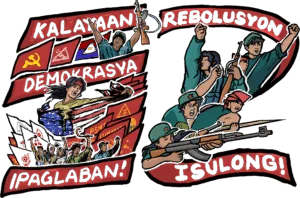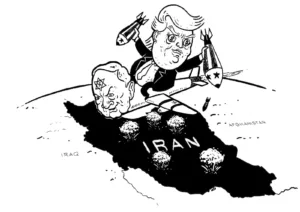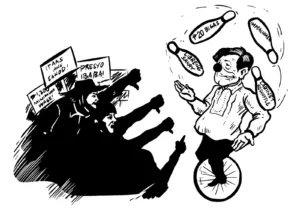By D. L. MONDELO
Correspondent, Bulatlat
http://www.bulatlat.com/main/2010/05/22/campaign-contributions-pre-programming-key-to-aquino-victory-sison/
22 May 2010
1. What can you say about the conduct of the 2010 elections?
Jose Maria Sison: The conduct of the 2010 elections shows the rottenness of the US-dominated ruling system of big compradors and landlords. It was a process dominated by the coalitions, parties and candidates of the reactionary ruling classes. Beforehand, it excluded the leaders of the working people who were repressed or who were without campaign funds. It was merely a personality-based contest of the political agents of the same exploiting classes.
They did not offer any strong differences in terms of program. They mouthed slogans against poverty and corruption and the need for change. But they said nothing about overcoming the three monsters of foreign monopoly capitalism, domestic feudalism and bureaucrat capitalism which exploit, impoverish and oppress the people. They gave no serious attention to the worsening crisis of the domestic ruling system and the world capitalist system.
The bilateral alliance of Makabayan and the Nacionalista Party (NP) put forward a common program for land reform, food self-reliance and rural development, expansion of domestic manufacturing and job opportunities, respect for human rights, peace negotiations, ecological protection, review of the Visiting Forces Agreement and independent foreign policy. But the NP downplayed the program.
The biggest winners in the elections were those who attacked the hated Arroyo regime and who benefited most from the biggest collection of campaign money from the big foreign and local businessmen. At the beginning of the campaign, the Liberal Party pretended to rely on piso-piso contributions but it eventually collected and used the biggest amount of campaign money from the big businessmen, thus surpassing the Nacionalista Party in spending.
The unbelievably large leads of Noynoy Aquino over Estrada and Villar have aroused the inquiries into whether the election results were pre-programmed. There are reports that the foreign controllers of the automated system and the Kamag-anak Inc. were able to pre-program the results of the presidential and vice presidential elections. Complaints against poll irregularities are widespread and cast doubts on the veracity of the vote count
2. Can you explain further the victory of Noynoy Aquino?
Let us take in chronological order the factors that allowed Noynoy Aquino to get ahead of his principal rivals, especially Villar who appeared to be the No. 1 presidential candidate before Cory Aquino died and before Noynoy decided to run for the presidency.
Noynoy Aquino had a clever and agile set of propagandists who had a clear strategic line. To obscure his involvement in the Hacienda Luisita massacre and his palaboy record as a non-achiever in the Lower House and Senate , he was touted as the upright heir of his parents and as a moral crusader against corruption and he attacked the corruption of the Arroyo regime in order to ride on the widespread and bitter anti-Arroyo sentiment of the people.
Villar did not attack Arroyo in a strong way and became vulnerable to the Villaroyo line or charge of being the secret candidate of Arroyo. In the early part of April, the results of two major survey polls done by firms owned and controlled by Aquino relatives and friends were accordingly used to bring down Villar in the mass media. The precipitous decline of Villar was further aggravated subsequently by the attacks from Estrada and Enrile about the 2007 initial public offering of the shares of stocks of the Villar real estate company.
Of all the reactionary parties, the Liberal Party raised the biggest amount of campaign money to surpass the volume of pro-Villar informercials in both TV and radio and other forms of propaganda. The Villar money was eventually no match to the contributions from Razon, Pangilinan, Ayala and other bigshots of the Makati Busines Club and from the foreign big businessmen. The Arroyo couple did not deliver to the Lakas presidential candidate the money that they had collected for the campaign.
There are indications that Noynoy Aquino was able to take incredibly big leads over Estrada and Villar because of pre-programming of the vote count. This is the biggest possible form of cheating and the most difficult to prove in contrast to the anomalous shading of the ovals before and during the elections in specific localities. The automated electoral system does not prevent the cheating tactics of the past but in fact allows cheating in a bigger and faster way.
3. What did the electoral campaign and results reveal about the Makabayan and the progressive party list groups?
Makabayan and the progressive party list groups proved themselves outstanding in putting forward the national and democratic demands of the people. They also got far more votes than any of the pseudo-progressive grouplets. Makabayan got nearly ten per cent of the actual nationwide voters for each of its two senatorial candidates, Satur Ocampo and Liza Maza. And all together the progressive party list groups also got nearly ten per cent. I believe that Makabayan and the progressive party list groups had more than 10 percent of the electorate, if not for the vote shaving by the pre-programmers.
Most of the votes for Villar are equivalent to the basic electoral base of Makabayan and the progressive party list groups. Definitely, Villar benefited more from the NP-Makabayan alliance than Makabayan did. But by his refusal to denounce the Arroyo regime as strongly as did Aquino and Estrada, Villar prejudiced not only himself but also his Makabayan teammates. It preventedthe Makabayan senatorial candidates from benefiting from the anti-Arroyo sentiment and increasing their votes beyond their basic electoral base.
However, the progressive party list groups remain a significant bloc with a high potential as a swing force within the reactionary congress. Makabayan could have been a more effective force had it been able to build itself as a party from top to bottom, with organs, units and candidates at every level long before the elections. Before the elections, Makabayan had limited capacity for negotiating with major parties. It was limited to pushing only two senatorial candidates and some candidates here and there at lower levels when it made an alliance with the NP.
The NP was publicly known as the only major party willing to have an alliance and share campaign resources. But its leadership obviously monopolized decisions over the downplaying of the program, the strategy of the campaign, the deployment of resources and other important matters. If it had a strong organization of its own, Makabayan could have been more assertive and could have fared better in an alliance with the NP.
While Makabayan had difficulties in ensuring the election of its two senatorial candidates, the progressive party list groups had far better chances in having more than ten of its nominees elected as members of Congress than Makabayan. But it is highly probable that the preprogrammers of the results of the elections were determined to cut down the number of winners among the nominees of the progressive party list groups.
During the electoral campaign, barefaced anti-communists and the pseudo-progressives tried to Red bait and equate Makabayan and the progressive party list groups with the CPP. And after the elections, they would mock the CPP as having failed to make any big electoral advance. The public knows that revolutionary forces are not equivalent to any electoral party. They measure their success in terms of increasing the revolutionary mass base and armed strength in the people's war and not in terms of taking seats within the reactionary government.
4. What do you expect of the presidency of Benigno Aquino III?
JMS: The Aquino regime will pursue basically the same exploitative and oppressive policies dictated to the Arroyo regime by US imperialism. It will not solve but will aggravate the problems of the Filipino people, such as foreign monopoly capitalism, domestic feudalism and bureaucrat capitalism.
The Aquino regime will continue to carry out liberalization, privatization, deregulation, curtailment of social rights, reduction of social services and increased taxation at the expense of the people under the US-dictated policy of free market globalization. US troops will continue to maintain forward stations and engage in military intervention under the pretext of combating terrorism. The Aquino regime will continue the US-dictated Oplan Bantay Laya under a new name and will generate a new wave of human rights violations
US and foreign banks and corporations will continue to extract superprofits and plunder the country. The Aquino regime will be grossly incapable of stopping the widening trade and budgetary deficits and the mounting debt burden. The fiscal and sovereign debt crisis will shake the Philippine economy from the base to the rafter and will be used by the foreign banks and corporations to further bend the Philippines.
As during the Cory Aquino administration, the Kamag-Anak Inc. will be at the head of big landlord and big comprador operations. While the regime might still tout a bogus land reform program, the Cojuangco-Aquinos intend to use layers of corporations to frustrate land reform in Hacienda Luisita and other landed estate. They are poised to benefit greatly from the corrupt practices of the high bureaucrat and big comprador.
The Aquino regime will try to broaden its support f from various reactionary parties in Congress, including the Lakas-Kampi party of Arroyo. But the worsening socio-economic crisis of the ruling system will tend to intensify the political contradictions among the reactionaries. There will be rising waves of legal mass protests and revolutionary resistance by the broad masses of the people. Ever aggravating the basic problems of the Filipino people, the Aquino regime will use brute force in a futile attempt to suppress the resistance of the people
5. Would the Aquino regime pursue peace negotiations with the revolutionary forces represented by the National Front of the Philippines?
JMS: It may or may not. It remains to be seen whether it is seriously interested in peace negotiations. It can easily pretend to be for peace negotiations like the Arroyo regime did. But it can set preconditions and use various tactics in order to avoid complying with The Hague Joint Declaration of 1992 and the subsequent agreements and thereby prevent the peace negotiations from addressing the roots of armed conflict through, social, economic and political reforms.
The same military hawks and clerico-fascists who undermined and hampered peace negotiations with the NDFP during the time of Arroyo are now with the Aquino regime. The puppet president and his security advisers get guidance from the US security policy of counterinsurgency and anti-terrorism so-called and take detailed instructions from various US agencies represented in the US country team.
I will not be surprised if instead of agreeing to resume the peace negotiations, comply with the existing agreements and begin concentrated negotiations on social and economic reforms the Aquino regime would set preconditions like indefinite ceasefire and front-loading the end of hostilities in vainly seeking the self-disintegration and pacification of the revolutionary movement.
According to the US Counterinsurgency Guide, the policy dictate of the US is for the puppet government to disarm, dismantle and reintegrate the revolutionary forces or in other words to destroy, coopt or reduce them to irrelevance or inconsequentiality. The US imperialists and their puppets conjure the illusion of peace negotiations at the national level if only to push further sham localized peace talks with their own agents and undertake palliative or band-aid measures in localities in order to deceive the people and to escalate military campaigns of suppression.
The imperialists and their puppets are also trying a new tack like pacifying or appeasing the Moro Islamic Liberation Front and other Moro revolutionary groups with foreign funds in order to unleash more military forces against the revolutionary forces of the NDFP. But the Communist Party of the Philippines and the New People's Army have already issued comprehensive statements for advancing the strategic defensive to the strategic stalemate in the people's war within the next five years.








